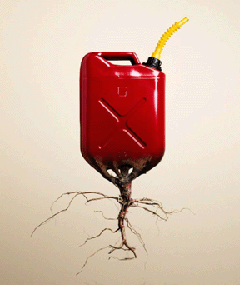Energizing Biofuel
Air Date: Week of May 8, 2009
 |
The Obama administration has given the biofuels industry a major boost. It’s providing the agro-energy industry with nearly three quarters of a billion dollars and proposing new rules to help accelerate development of advanced fuels. Host Steve Curwood talks with Jim Lane, publisher and editor of BioFuels Digest about the future of biofuels.
Transcript
CURWOOD: The Obama administration has given biofuels a major boost. The President has announced he’ll tap nearly $800 million from the economic recovery package to fuel agro-energy research and speed up commercialization.
And to ensure biofuels don’t aggravate to climate change or displace food crops for fuel, the Administration also created an interagency group made up of the EPA, and the departments of Agriculture and Energy.
To learn more now, we turn to Jim Lane, he’s publisher of Biofuels Digest. Hi Jim!
LANE: Hi Steve. Good to be here.
CURWOOD: Jim, let’s talk about the big picture here and then get into some of the details. First, there’s what three quarters of a billion dollars to develop advanced biofuels. Where’s this dough gonna go?
LANE: Well it’s gonna go into three buckets. And the first bucket is going to be an investment in accelerating the commercialization of cellulosic biofuels, and that is to get it out of the labs and onto the street. And the second bucket is designed to keep those plants that are already receiving some funding on their commercialization path, because it’s been pretty hard for them to take the money they’ve already received and turn that into fuel because of all the financial crisis. And the third bucket is to put more money into what are called drop-in fuels, and that’s a great solution for biofuels.

The hungry reached for food in Pakistan during last year’s food crisis. Many fear raising crops for biofuel could force up food prices again. (Photo: Raja Islam)
CURWOOD: What is a drop-in fuel?
LANE: A drop-in is made from biomass but it behaves exactly like diesel or gasoline. It’s called green diesel or green gasoline. So it’s made from bio energy, but when you put it in your car, you don’t need to make any adjustments in the infrastructure, you don’t need to change national pipelines. And basically you can distribute it and use it the same way you use it the same way you do your current fuel, it just has a better emissions picture and it’s certainly made at home and available now.
CURWOOD: For example?
LANE: Well, we can make fuel from algae. And they’re a great solution. They’re called third generation fuels because they don’t change the way we operate our vehicles.
CURWOOD: Jim, do some math here for me. The 2007 Farm Bill requires the United States to produce what some 36 billion gallons of biofuels a year, and that’s designed to cut eleven percent of our greenhouse gas emissions. That would be like taking some 24 million cars off the road. So what are the fuels that we’re gonna use to hit that target?
LANE: Well we’re gonna have fifteen billion gallons are gonna come from conventional biofuels, that’s the corn ethanol and soy based biodiesel that we are currently using today. So it means that we’re not going to be using too much more of that. And then we’re gonna get 16 billion gallons from cellulosic biofuels, and these are made from agricultural residues such as corn stover, stalks, made from forest residues, also made from waste, landfills. And then we’re gonna get four billion gallons of advanced biofuels and these are these drop-in fuels that we’ve talked about made perhaps from algae and other bio energies like that. And then we’ll get a billion gallons of biodiesel, and that’ll be made primarily from soy and from camelina and other kinds of crops like that.

LANE: Well it addresses it in two ways, its very clever actually. First of all, they’ve changed some of the definitions to make them more fuel neutral, so they no longer call for things like cellulosic ethanol, they’re asking for cellulosic biofuels. So, you know, we can fulfill that in a variety of ways, we don’t necessarily have to make ethanol. Secondly, they’ve capped – and this has been for some time – they’ve capped the amount of corn ethanol at 15 billion gallons and we’re very close to that already. So, the message from Washington is very clear that corn ethanol is here to stay, but very much in the volumes that we’re looking at right now, and the future is very much in these advanced biofuels that do not use, in many cases, any land because they’re using residues and waste matter that’s already there or they’re using very high yield substances like algae where we get ten to fifteen times the productivity per acre than we get from corn. So, it’s a real game changer as well as acceleration.
CURWOOD: So, looking at the president’s directive, it asks this interagency group to look at the overall, the life cycle, global warming implications of the new biofuels. How are they going to calculate that?
LANE: Well there’s a direct impact that’s called field to wheels and they measure all the various inputs that go in and some of those are fossil fuels, such as moving fuel and moving feed stock to the plant and from the plant. Then there’s an indirect component and the theory here is that if you produce a lot of biofuels using existing crop land, that’s gonna raise the prices and that will encourage people to do conversion of fallow land or land used for less profitable items such as cattle to bioenergy or food production. So that’s called an indirect impact and that can have emissions. So, it’s very early days in measuring that. There is a model called the GTAP model which is produced by Purdue, and there’s a lot of controversy in the scientific community and there will be a lot of discussion over the next sixty days about exactly how that’s implemented. And I think that as we look at the details that are coming through here, I think we can see that the administration has actually come up with a really, really good way to approach this where they’ve protected to past, but really put us on a future course that’s going to get us into these third generation drop-in fuels very quickly.
CURWOOD: Jim Lane is the editor and publisher of “Biofuels Digest.” Thank you so much, sir.
LANE: Thank you.
Links
Living on Earth wants to hear from you!
Living on Earth
62 Calef Highway, Suite 212
Lee, NH 03861
Telephone: 617-287-4121
E-mail: comments@loe.org
Newsletter [Click here]
Donate to Living on Earth!
Living on Earth is an independent media program and relies entirely on contributions from listeners and institutions supporting public service. Please donate now to preserve an independent environmental voice.
NewsletterLiving on Earth offers a weekly delivery of the show's rundown to your mailbox. Sign up for our newsletter today!
 Sailors For The Sea: Be the change you want to sea.
Sailors For The Sea: Be the change you want to sea.
 The Grantham Foundation for the Protection of the Environment: Committed to protecting and improving the health of the global environment.
The Grantham Foundation for the Protection of the Environment: Committed to protecting and improving the health of the global environment.
 Contribute to Living on Earth and receive, as our gift to you, an archival print of one of Mark Seth Lender's extraordinary wildlife photographs. Follow the link to see Mark's current collection of photographs.
Contribute to Living on Earth and receive, as our gift to you, an archival print of one of Mark Seth Lender's extraordinary wildlife photographs. Follow the link to see Mark's current collection of photographs.
 Buy a signed copy of Mark Seth Lender's book Smeagull the Seagull & support Living on Earth
Buy a signed copy of Mark Seth Lender's book Smeagull the Seagull & support Living on Earth

